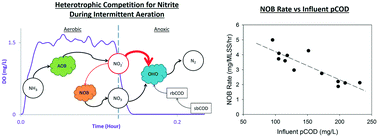当前位置:
X-MOL 学术
›
Environ. Sci.: Water Res. Technol.
›
论文详情
Our official English website, www.x-mol.net, welcomes your
feedback! (Note: you will need to create a separate account there.)
Effect of influent carbon fractionation and reactor configuration on mainstream nitrogen removal and NOB out-selection
Environmental Science: Water Research & Technology ( IF 3.5 ) Pub Date : 2019/12/20 , DOI: 10.1039/c9ew00873j Stephanie A. Klaus 1, 2, 3, 4, 5 , Michael S. Sadowski 1, 2, 3, 4 , Maureen N. Kinyua 4, 6, 7, 8 , Mark W. Miller 4, 9, 10 , Pusker Regmi 4, 9, 10 , Bernhard Wett 11, 12, 13 , Haydée De Clippeleir 4, 14, 15 , Kartik Chandran 4, 16, 17, 18 , Charles B. Bott 4, 5, 19
Environmental Science: Water Research & Technology ( IF 3.5 ) Pub Date : 2019/12/20 , DOI: 10.1039/c9ew00873j Stephanie A. Klaus 1, 2, 3, 4, 5 , Michael S. Sadowski 1, 2, 3, 4 , Maureen N. Kinyua 4, 6, 7, 8 , Mark W. Miller 4, 9, 10 , Pusker Regmi 4, 9, 10 , Bernhard Wett 11, 12, 13 , Haydée De Clippeleir 4, 14, 15 , Kartik Chandran 4, 16, 17, 18 , Charles B. Bott 4, 5, 19
Affiliation

|
An intermittently aerated, pilot scale biological nitrogen removal process was operated in modified Lüdzack Ettinger (MLE) and fully intermittent aeration (all reactors aerated) configurations. The process was fed both A-stage effluent (ASE), and primary clarifier effluent (PCE), which differ in chemical oxygen demand (COD) composition. The objective was to determine the effects of influent carbon fractionation and reactor configuration on nitrite oxidizing bacteria (NOB) out-selection and total inorganic nitrogen (TIN) removal during intermittent aeration. TIN removal was affected by both the type and amount of influent COD, with particulate COD (pCOD) having a stronger influence than soluble COD (sCOD). NOB out-selection was lowest in the MLE configuration, regardless of the feed, and highest in fully intermittent configuration with A-stage feed. During fully intermittent operation with A-stage effluent feed, nitrite accumulation correlated positively with influent particulate COD concentration, and correlated negatively with ex situ NOB activity rates. In addition, ex situ denitrification batch tests showed that nitrite was consumed faster than nitrate when NOB rates were low. These observations suggested that pCOD improved heterotrophic competition for nitrite, leading to ammonia oxidation rates higher than nitrite oxidation rates. Therefore, the influent COD fractions should be tailored to achieve the desired nitrogen removal goals downstream.
中文翻译:

进水碳分馏和反应器配置对主流氮去除和NOB选择的影响
在改良的LüdzackEttinger(MLE)和完全间歇曝气(所有反应器都加气)配置下运行间歇曝气,中试规模的生物脱氮工艺。向该工艺中同时供给了A级废水(ASE)和一级澄清池废水(PCE),它们的化学需氧量(COD)组成不同。目的是确定进水碳分馏和反应器配置对间歇曝气期间亚硝酸氧化细菌(NOB)的选择和总无机氮(TIN)去除的影响。TIN的去除受进水COD的类型和数量的影响,其中颗粒COD(pCOD)的影响要大于可溶性COD(sCOD)。无论进料如何,在MLE配置中NOB的选择最低,而在A级进料的完全间歇性配置中NOB的选择最高。易地NOB活动率。此外,异位反硝化分批测试表明,当NOB速率低时,亚硝酸盐的消耗速度比硝酸盐消耗的快。这些观察结果表明,pCOD改善了亚硝酸盐的异养竞争,导致氨氧化速率高于亚硝酸盐氧化速率。因此,应调整流入的COD馏分,以实现下游所需的氮去除目标。
更新日期:2020-03-05
中文翻译:

进水碳分馏和反应器配置对主流氮去除和NOB选择的影响
在改良的LüdzackEttinger(MLE)和完全间歇曝气(所有反应器都加气)配置下运行间歇曝气,中试规模的生物脱氮工艺。向该工艺中同时供给了A级废水(ASE)和一级澄清池废水(PCE),它们的化学需氧量(COD)组成不同。目的是确定进水碳分馏和反应器配置对间歇曝气期间亚硝酸氧化细菌(NOB)的选择和总无机氮(TIN)去除的影响。TIN的去除受进水COD的类型和数量的影响,其中颗粒COD(pCOD)的影响要大于可溶性COD(sCOD)。无论进料如何,在MLE配置中NOB的选择最低,而在A级进料的完全间歇性配置中NOB的选择最高。易地NOB活动率。此外,异位反硝化分批测试表明,当NOB速率低时,亚硝酸盐的消耗速度比硝酸盐消耗的快。这些观察结果表明,pCOD改善了亚硝酸盐的异养竞争,导致氨氧化速率高于亚硝酸盐氧化速率。因此,应调整流入的COD馏分,以实现下游所需的氮去除目标。











































 京公网安备 11010802027423号
京公网安备 11010802027423号